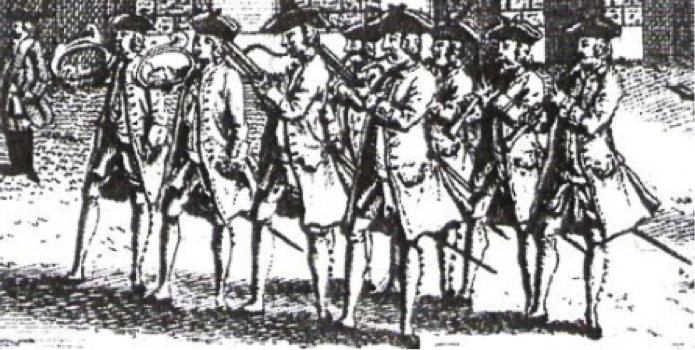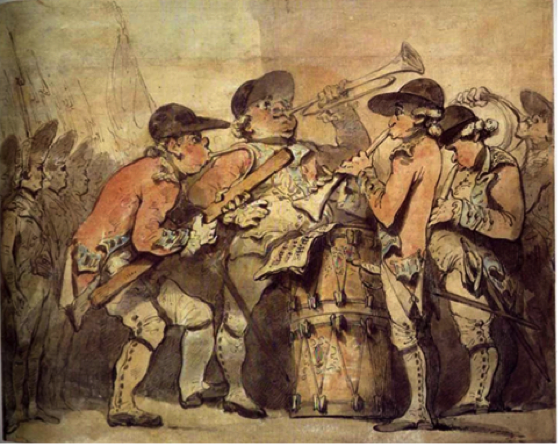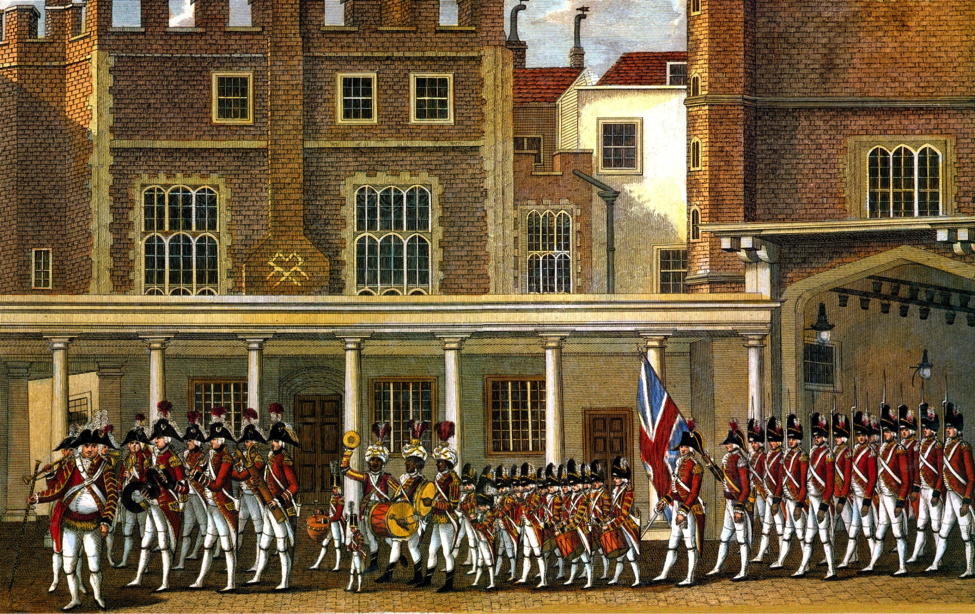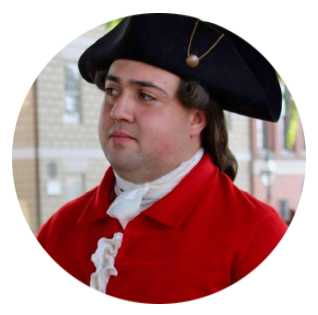Bands of Music in the British Army 1762-1790
"The band of Musick very fine. The whole perfectly well cloathed and appointed"
On the 9th of March, 1768, Alexander Mackrabie wrote to his sister to describe his time in Philadelphia. Unfortunately for him, he writes, "at this place and at this season there is so little of anything amusing." In order to pass the time, Mr. Mackrabie described a recent practice in the city that was "extremely in vogue" called "Serenading."
We---with four or five young officers of the regiment in barracks---drink as hard as we can to keep out the cold, and about midnight sally forth, attended by the Band which consists of ten musicians, horns, clarionets, hautboys, and bassoons, march through the streets and play under the window of any lady you choose to distinguish, which they esteem a high Compliment. . . . I have been out twice and only once got a violent cold by it.[1]

Bands of Music, also known simply as bands, were another musical entity that existed in the British Army. It is at this point that a distinction must be made between drums and fifes and bands of music. Drummers and fifers were enlisted to play the drum and fife for various duties in camp, signals in battle, and other martial ceremonies. In a regiment of foot, only the grenadier company was allowed two fifers. The other companies were only officially allowed one drummer per company, with the light company typically swapping its drummer for a horn player.[2]
Instrumentation of a band varied by regiment but generally followed the German tradition of Harmoniemusik, or wind music. Typically scored for at least 6 instruments, compositions included parts for clarinets, hautboys (known today as oboes), horns, and bassoons.[3]
A roll for the musicians of the 23rd Regiment exists from 1786. The leader, or Band Master was Jacob LeCroix. Under him were 2 clarinets, 2 hautboys, 2 bassoons, 2 horns, and a timpani player. All of the men under LeCroix served in America, with the newest member of the band having served 5 years by 1786.[4]
When the band of the Royal Artillery was formed in 1762, Lieutenant-Colonel Phillips came up with Articles of Agreement. They laid out rules that most other regiments would unofficially use for their own bands.
- The band to consist of eight men. who must also be capable to play upon the violoncello, bass, violin and flute, as other common instruments.
- The regiment's musick must consist of two trumpets, two French horns, two bassoons, and four hautbois or clarinets ; these instruments to be provided by the regiment, but kept in repair by the head musician.
- The musicians will be looked upon as actual soldiers, and cannot leave the regiment without a formal discharge. The same must also behave them, according to the articles of war.
- The aforesaid musicians will be clothed by the regiment.
- [In the handwriting of Colonel Phillips.] Provided the musicians are not found to be good performers at their arrival they will be discharged, and at their own expense. This is meant to make the person who engages the musicians careful in his choice.”[5]

As seen in the Royal Artillery Articles of Agreement, bands were typically made up of private soldiers. These men would receive extra pay from the officers of a regiment to supplement their wages as well as buying instruments. The soldiers were not drummers and fifers; instead, they were known as musicians. Despite being soldiers, these men were talented professional musicians, often able to play multiple instruments. Members of the band did not play or typically fight in battle but instead fulfilled other duties, military and non-military.[6]
It was not uncommon for drummers or fifers to also be members of the band. William Simpson of the 29th Regiment deserted from New York in December of 1770. In his description, his officer wrote that Simpson
"plays well on the Flute and Fife, and plays a little on the Violin and French Horn. Had on when he went away, a short yellow Coat, fac'd Red,. . . the Coat lac'd with Drummers' Lace."
William Simpson was most likely a fifer in the 29th but because he could play multiple instruments, it is possible he was in the band. [7]

Now that we know what a band was and who their musicians were, the next post will cover the duties and repertoires of these "genteel corps of music."
Footnotes: [1] Philip France, Beata Francis, Eliza Keary, C. F. Keary, and Junius, The Francis Letters, New York: E.P. Dutton and Co., 1901, Pages 89-92, Accessed September 3, 2017, https://archive.org/details/cu31924088024413.[2] John Williamson, The Elements of Military Arrangement; Comprehending the Tacktick, Exercise, Manoevers, and Discipline of the British Infantry, with an Appendix, containing the substance of the principal standing Orders and Regulations for the Army, London: John Wiliamson, 1781, Page 7. Courtesy of Andrew Kirk[3] https://www.lipscomb.edu/windbandhistory/rhodeswindband_04_classical.htm[4] Sherri Rapp, British Regimental Bands of Musick: The Material Culture of Regimental Bands of Music According to Pictorial Documentation, Extant Clothing, and Written Descriptions 1750-1800, Accessed September 4, 2017, https://www.scribd.com/presentation/215381883/British-Bands-of-Musick[5] Ibid.[6] Williamson, The Elements, London: John Wiliamson, 1781, Page 7[7] The New-York Gazette or the Weekly Post-Boy, September 17, 1770, Page 4
 JOSHUA MASONJoshua is an undergraduate student at Rhode Island College majoring in Secondary Education and History. He's been researching fifers, drummers, and bands of music during the eighteenth century for the past 5 years.
JOSHUA MASONJoshua is an undergraduate student at Rhode Island College majoring in Secondary Education and History. He's been researching fifers, drummers, and bands of music during the eighteenth century for the past 5 years.

